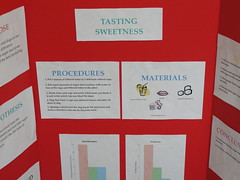
This is it - the big day is finally here! Everyone will be looking at your science fair display board, reading your report, and listening to your presentation. How do you show off your work in the best possible way?
Everything you've done must be summarized here. This is your chance to show the world what you've learned from your experiment. Your science fair display and report are the ways the judges will remember your project when they make their decision. While it's very important that your scientific work was accurate, that's not everything.
So how should you present your project?

Let's look at the basics. Your display should consist of a back board, sometimes sold specifically as a science fair display board (Get it Here), a project report, graphs and charts, and some representation of your experiment.
Of course it would be great if you could also bring your experiment into the fair, but if it's too big, or if it was strictly observational, consider bringing in photographs or a part of the experimental apparatus. Some people even bring in a small television or laptop and show a video presentation of their project.
Whatever methods you choose, your presentation has to represent your project in such a way that it holds the interest of the judges--so be creative, but keep it simple.
The size and shape of science fair display boards can vary, so be sure to check the rules. Common maximum sizes are 48 inches wide, 30 inches deep, and 108 inches from the floor. Generally speaking, no matter the size, a traditional display board is divided into three sections: the main center section, and two "wings" which are folded toward the front. They can be made from scratch from heavy cardboard or wood, or can be ordered inexpensively over the internet.
Now, think about the things you'll want to attach to the science fair display board. Some competitions, and most teachers, have rules or guidelines for what should be included. These might include cut-out lines of text which detail your original question (which will be your project topic), your hypothesis, results, conclusions, and other information including charts and graphs.
The title of your project should always go on the center panel at the top of your display board. It must be large enough so that people can see it from about three feet away. The other pieces of text can be smaller, and should be placed in a logical order. In other words, let the judges read your hypothesis before they read your conclusions.
Several years ago, it was common to use stenciled or cut-out letters. Now that most students have access to computers and printers, it is more common for these lines of text to be printed in large letters. There is no rule about this, but be aware that looks do matter. A word printed on a laser printer looks a lot better than one drawn and colored with a marker.
It's very important that your science fair display board will be something the judges will remember in a good way, and not just because it used bright colors and big letters. You want it to be well-organized and uncluttered so the judges aren't distracted. Make it look professional, and the judges will treat your project professionally.
Your teacher may require an in-class report and presentation of your science project. Or it could just be for the judges at the competition. Either way, you will probably have to give an oral presentation discussing your experiment and results. There may or may not be a time limit, but it's always helpful to keep your presentation short and to-the-point. Be sure that your report touches on all of the elements of your project, including but not limited to the points of the Scientific Method.
Be sure to practice, preferably in front of an audience. Giving an oral presentation and talking to the judges, who may be teachers or professionals you've never met before, is often the hardest part for many students. Practice will give you the confidence you need to sound like an authority in your area of research, and that's something that the judges like to hear.
Points are awarded for your ability to discuss the project clearly, explaining each stage of your research and every step of your experiment. The judges will ask you questions, so practice will really help. Have someone you know ask you questions about your project. It might make you think about things that you haven't considered before.
NEVER make up answers to difficult questions. Instead of admitting that you don't know, tell the judges that you didn't discover the answer to that question during your research, and then present other, relevant information.
It may not seem right, but your appearance may affect how the judges view you. A professional appearance will reflect well on you and your project. You are not only trying to look professional yourself, but also to make your project look like the result of thoughtful, mature, and professional scientific research.
/In summary, it's important that you have a professional-looking, well-organized science fair display board to make a good impression on the judges. It try to appear relaxed and knowledgable while presenting your science fair report.